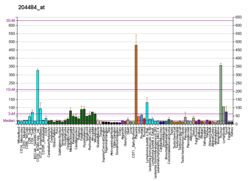PIK3C2B
Phosphatidylinositol-4-phosphate 3-kinase C2 domain-containing beta polypeptide is an enzyme that in humans is encoded by the PIK3C2B gene.[5][6][7]
Function
The protein encoded by this gene belongs to the phosphoinositide 3-kinase (PI3K) family. PI3-kinases play roles in signaling pathways involved in cell proliferation, oncogenic transformation, cell survival, cell migration, and intracellular protein trafficking. This protein contains a lipid kinase catalytic domain as well as a C-terminal C2 domain, a characteristic of class II PI3-kinases. C2 domains act as calcium-dependent phospholipid binding motifs that mediate translocation of proteins to membranes, and may also mediate protein-protein interactions. The PI3-kinase activity of this protein is sensitive to low nanomolar levels of the inhibitor wortmannin. The C2 domain of this protein was shown to bind phospholipids but not Ca2+, which suggests that this enzyme may function in a calcium-independent manner.[7]
References
- GRCh38: Ensembl release 89: ENSG00000133056 - Ensembl, May 2017
- GRCm38: Ensembl release 89: ENSMUSG00000026447 - Ensembl, May 2017
- "Human PubMed Reference:". National Center for Biotechnology Information, U.S. National Library of Medicine.
- "Mouse PubMed Reference:". National Center for Biotechnology Information, U.S. National Library of Medicine.
- Brown RA, Ho LK, Weber-Hall SJ, Shipley JM, Fry MJ (Apr 1997). "Identification and cDNA cloning of a novel mammalian C2 domain-containing phosphoinositide 3-kinase, HsC2-PI3K". Biochemical and Biophysical Research Communications. 233 (2): 537–44. doi:10.1006/bbrc.1997.6495. PMID 9144573.
- Arcaro A, Volinia S, Zvelebil MJ, Stein R, Watton SJ, Layton MJ, Gout I, Ahmadi K, Downward J, Waterfield MD (Dec 1998). "Human phosphoinositide 3-kinase C2beta, the role of calcium and the C2 domain in enzyme activity". The Journal of Biological Chemistry. 273 (49): 33082–90. doi:10.1074/jbc.273.49.33082. PMID 9830063.
- "Entrez Gene: PIK3C2B phosphoinositide-3-kinase, class 2, beta polypeptide".
Further reading
- Lee C, Liu QH, Tomkowicz B, Yi Y, Freedman BD, Collman RG (Nov 2003). "Macrophage activation through CCR5- and CXCR4-mediated gp120-elicited signaling pathways". Journal of Leukocyte Biology. 74 (5): 676–82. doi:10.1189/jlb.0503206. PMID 12960231.
- Kozutsumi H, Toyoshima H, Hagiwara K, Yazaki Y, Hirai H (Oct 1994). "Human ltk receptor tyrosine kinase binds to PLC-gamma 1, PI3-K, GAP and Raf-1 in vivo". Oncogene. 9 (10): 2991–8. PMID 8084603.
- Milani D, Mazzoni M, Borgatti P, Zauli G, Cantley L, Capitani S (Sep 1996). "Extracellular human immunodeficiency virus type-1 Tat protein activates phosphatidylinositol 3-kinase in PC12 neuronal cells". The Journal of Biological Chemistry. 271 (38): 22961–4. doi:10.1074/jbc.271.38.22961. PMID 8798481.
- Ueno H, Honda H, Nakamoto T, Yamagata T, Sasaki K, Miyagawa K, Mitani K, Yazaki Y, Hirai H (Jun 1997). "The phosphatidylinositol 3' kinase pathway is required for the survival signal of leukocyte tyrosine kinase". Oncogene. 14 (25): 3067–72. doi:10.1038/sj.onc.1201153. PMID 9223670.
- Mazerolles F, Barbat C, Fischer A (Sep 1997). "Down-regulation of LFA-1-mediated T cell adhesion induced by the HIV envelope glycoprotein gp160 requires phosphatidylinositol-3-kinase activity". European Journal of Immunology. 27 (9): 2457–65. doi:10.1002/eji.1830270946. PMID 9341793.
- Borgatti P, Zauli G, Colamussi ML, Gibellini D, Previati M, Cantley LL, Capitani S (Nov 1997). "Extracellular HIV-1 Tat protein activates phosphatidylinositol 3- and Akt/PKB kinases in CD4+ T lymphoblastoid Jurkat cells". European Journal of Immunology. 27 (11): 2805–11. doi:10.1002/eji.1830271110. PMID 9394803.
- Borgatti P, Zauli G, Cantley LC, Capitani S (Jan 1998). "Extracellular HIV-1 Tat protein induces a rapid and selective activation of protein kinase C (PKC)-alpha, and -epsilon and -zeta isoforms in PC12 cells". Biochemical and Biophysical Research Communications. 242 (2): 332–7. doi:10.1006/bbrc.1997.7877. PMID 9446795.
- Milani D, Mazzoni M, Zauli G, Mischiati C, Gibellini D, Giacca M, Capitani S (Jul 1998). "HIV-1 Tat induces tyrosine phosphorylation of p125FAK and its association with phosphoinositide 3-kinase in PC12 cells". AIDS. 12 (11): 1275–84. doi:10.1097/00002030-199811000-00008. PMID 9708406.
- Jauliac S, Mazerolles F, Jabado N, Pallier A, Bernard F, Peake J, Fischer A, Hivroz C (Oct 1998). "Ligands of CD4 inhibit the association of phospholipase Cgamma1 with phosphoinositide 3 kinase in T cells: regulation of this association by the phosphoinositide 3 kinase activity". European Journal of Immunology. 28 (10): 3183–91. doi:10.1002/(SICI)1521-4141(199810)28:10<3183::AID-IMMU3183>3.0.CO;2-A. PMID 9808187.
- Arcaro A, Zvelebil MJ, Wallasch C, Ullrich A, Waterfield MD, Domin J (Jun 2000). "Class II phosphoinositide 3-kinases are downstream targets of activated polypeptide growth factor receptors". Molecular and Cellular Biology. 20 (11): 3817–30. doi:10.1128/MCB.20.11.3817-3830.2000. PMC 85707. PMID 10805725.
- Park IW, Wang JF, Groopman JE (Jan 2001). "HIV-1 Tat promotes monocyte chemoattractant protein-1 secretion followed by transmigration of monocytes". Blood. 97 (2): 352–8. doi:10.1182/blood.V97.2.352. PMID 11154208.
- Zauli G, Milani D, Mirandola P, Mazzoni M, Secchiero P, Miscia S, Capitani S (Feb 2001). "HIV-1 Tat protein down-regulates CREB transcription factor expression in PC12 neuronal cells through a phosphatidylinositol 3-kinase/AKT/cyclic nucleoside phosphodiesterase pathway". FASEB Journal. 15 (2): 483–91. doi:10.1096/fj.00-0354com. PMID 11156964.
- Wheeler M, Domin J (Oct 2001). "Recruitment of the class II phosphoinositide 3-kinase C2beta to the epidermal growth factor receptor: role of Grb2". Molecular and Cellular Biology. 21 (19): 6660–7. doi:10.1128/MCB.21.19.6660-6667.2001. PMC 99811. PMID 11533253.
- Deregibus MC, Cantaluppi V, Doublier S, Brizzi MF, Deambrosis I, Albini A, Camussi G (Jul 2002). "HIV-1-Tat protein activates phosphatidylinositol 3-kinase/ AKT-dependent survival pathways in Kaposi's sarcoma cells". The Journal of Biological Chemistry. 277 (28): 25195–202. doi:10.1074/jbc.M200921200. PMID 11994280.
- Cook JA, August A, Henderson AJ (Jul 2002). "Recruitment of phosphatidylinositol 3-kinase to CD28 inhibits HIV transcription by a Tat-dependent mechanism". Journal of Immunology. 169 (1): 254–60. doi:10.4049/jimmunol.169.1.254. PMID 12077252.
- Arcaro A, Khanzada UK, Vanhaesebroeck B, Tetley TD, Waterfield MD, Seckl MJ (Oct 2002). "Two distinct phosphoinositide 3-kinases mediate polypeptide growth factor-stimulated PKB activation". The EMBO Journal. 21 (19): 5097–108. doi:10.1093/emboj/cdf512. PMC 129034. PMID 12356726.
- Visnjić D, Crljen V, Curić J, Batinić D, Volinia S, Banfić H (Oct 2002). "The activation of nuclear phosphoinositide 3-kinase C2beta in all-trans-retinoic acid-differentiated HL-60 cells". FEBS Letters. 529 (2–3): 268–74. doi:10.1016/S0014-5793(02)03357-4. PMID 12372612.




